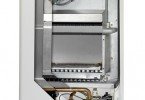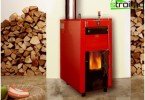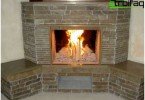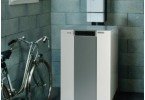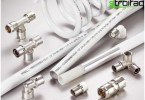Warm floor under linoleum
Each year gives us new ideas for interior design, original style solutions, amazing finishing materials and modern technologies aimed at creating comfort and coziness in the house. One of these innovations is underfloor heating, which appeared not so long ago, but quickly won the hearts of consumers. Is someone really going to refuse in the cold winter time to get out of bed and lower their bare feet not on cold linoleum or tiles, but on a pleasant and warm floor surface? Modern technologies make it possible to arrange a warm floor in any room and under any fine floor covering. However, in some cases it is necessary to take into account the features of this coating. So, underfloor heating under linoleum must meet a number of requirements.
Content
- Terms and conditions of selection
- The consequences of improper selection
Terms and conditions of selection
Today there are a huge number of the most different types of linoleums. These include linoleum:
- alkyd;
- multilayer, which is based on warm sound insulation;
- Relin (multi-layer rubber);
- polyvinyl chloride (PVC linoleum);
- on a woven base, etc..
When choosing a warm floor for a particular type of linoleum, it is worth considering that the temperature regime of its operation will become a fundamental criterion. This is due to the fact that, unlike other fine floor coverings – parquet boards, laminate or ceramic tiles – linoleum is quite demanding on the intensity of floor heating.
So, heating should occur smoothly, and heat should spread evenly.
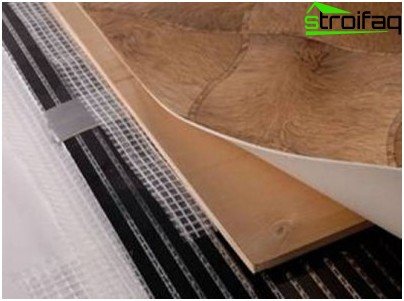
Only linoleum brands compatible with this heating system can be laid on top of the warm floor.
The recommended power rating of the installed underfloor heating should not exceed 150 W / m2. Such power is quite enough for the floor to heat up to a temperature of 26-28 ° C. It is worth noting that experts do not recommend achieving a temperature increase in any way, due to several reasons.
The consequences of improper selection
So, in the case of laying a warm floor with a slightly higher power, for example, 180-240 W / m2, the intensity of its heating increases significantly. As a result, this can lead to negative consequences, in particular, linoleum coating will suffer..
Firstly, linoleum can change its color in those places where the heating intensity is maximum. Secondly, it can move away from the floor surface, that is, swell. In addition, with excessive heating of linoleum, the process of the release of such a harmful substance as phenol can begin. This is especially undesirable if the family has small children or the room is poorly ventilated. With strong heating, not only the appearance of linoleum suffers, but also its operational characteristics. So, it becomes softer and unstable to break.
To determine the degree of heating of a warm floor, you just need to touch it with your hand. The surface of linoleum should not be very hot. To date, the most optimal option for floor heating under linoleum are infrared film floors.
Infrared film floor
The infrared underfloor heating offered to consumers under linoleum is a polymer film about 0.4 mm thick emitting infrared rays on its surface. As a heating element of such floors are black strips of graphite. It is on them that the voltage from the mains is supplied to the usual 220 V through copper-silver conductors. Graphite strips are sealed in a transparent polyester film.
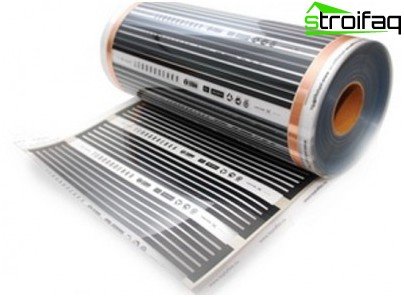
Infrared film underfloor heating – the best option for a heating system located under the linoleum
The use of graphite is due to the fact that its thermal conductivity is much higher than that of other materials. At the same time, its electromagnetic radiation is many times less, which allows to save on energy consumption and achieve greater heat transfer. Radiation of infrared waves and heating of the canvas begin to occur when a warm floor is connected to the mains through a special temperature controller.
The emitted infrared rays, heating all opaque objects in the living room, helps to maintain the required temperature in the room. Proper design and installation of an infrared film floor can reduce heating costs. This happens due to the fact that it is objects and people that are heated, and not the volume of air that is in the room.
Advantages of a film infrared floor
Infrared warm floor is a universal solution, as it can be easily combined with almost any type of linoleum. It allows you to get a fairly gentle type of heating that does not adversely affect the appearance and performance of the floor covering. This is due to both the impossibility of overheating and the frequent arrangement of conductor strips.
In addition, this floor heating system is easy to install, which does not take much time and can be done by a simple layman.
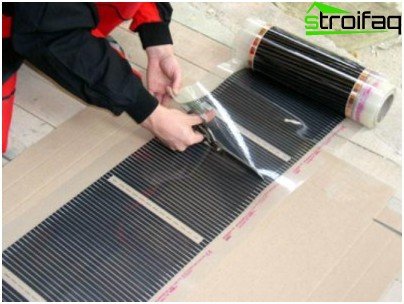
Thermal film is stacked in strips, between which there must be a distance of 1 cm
Another advantage of warm floors is their reliability and a high degree of resistance to various kinds of mechanical damage. So, with an external mechanical impact, only a certain part of the warm floor will be damaged, which can be replaced. The polymer film is resistant to corrosion for a long period of time..
Particular convenience in the installation of an infrared film floor makes it possible to lay it on various surfaces: vertical, horizontal and inclined. This is achieved due to the flexibility of the material..
If necessary, you can use the mobile version of the infrared floor, that is, part of the desired size is mounted to heat a mirror or place for a pet.
Experts say that infrared radiation has a beneficial effect on human health. So, with its help you can cure about 30 different diseases. This is another advantage of infrared film floors and a reason to opt for it..
Thus, modern technologies have made it possible to obtain an efficient, high-quality and safe floor heating system in a living room using far infrared radiation. The ability to lay such warm floors under linoleum attracts many consumers who are happy to operate them for several years.


